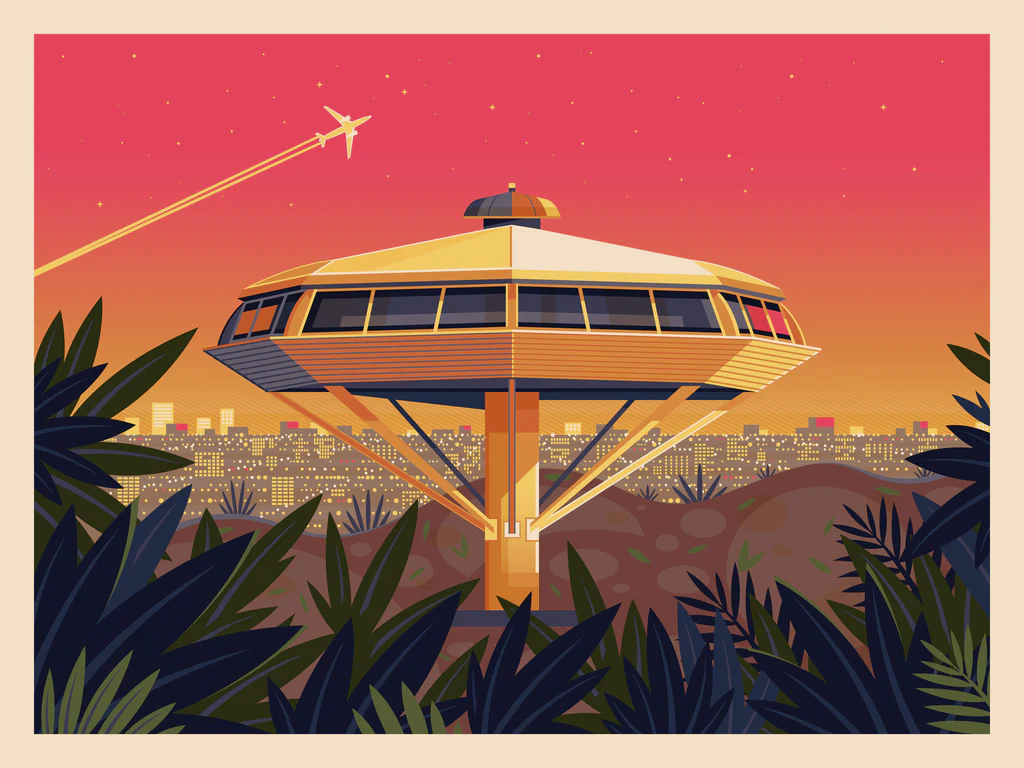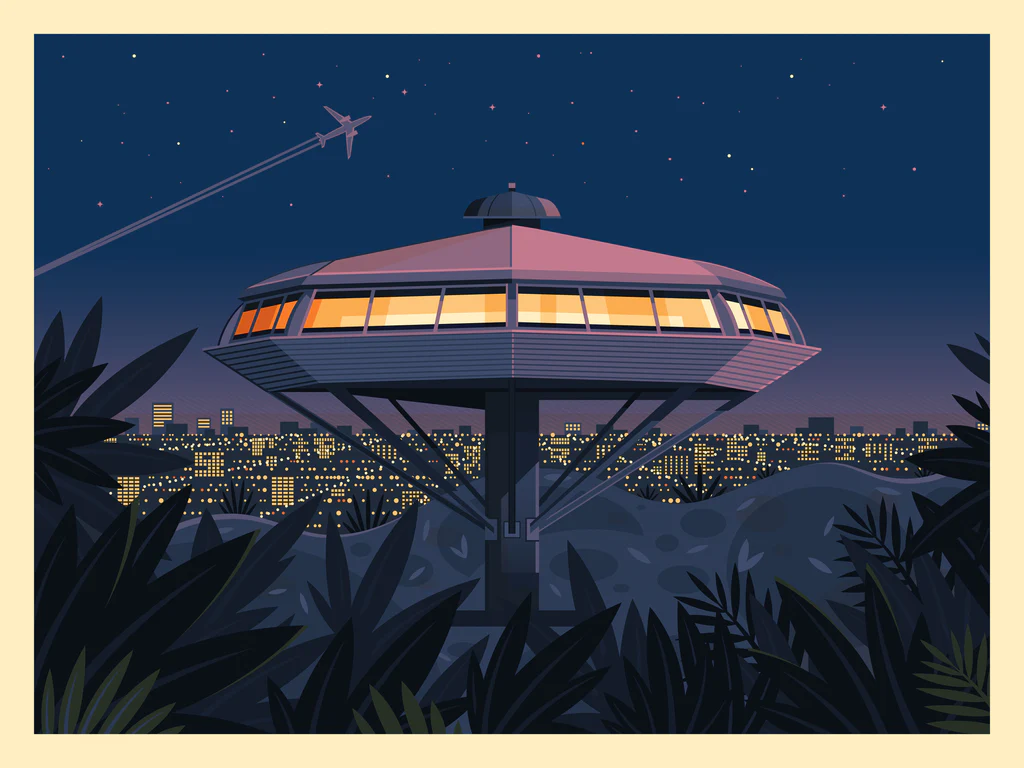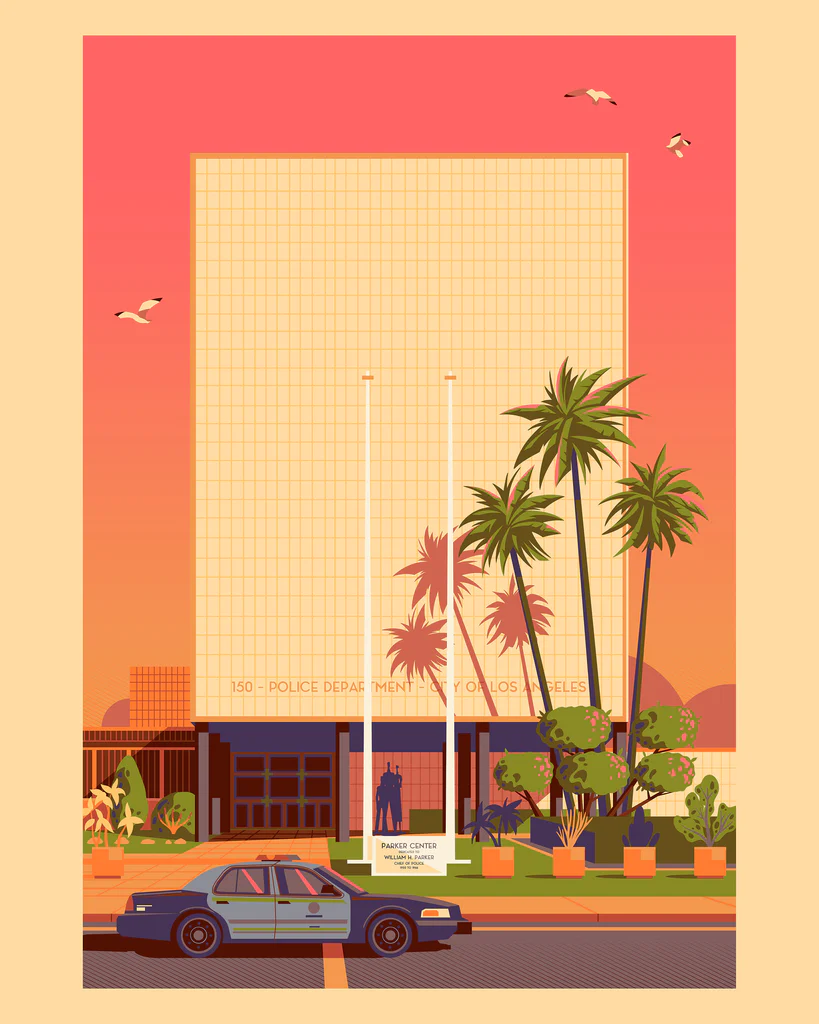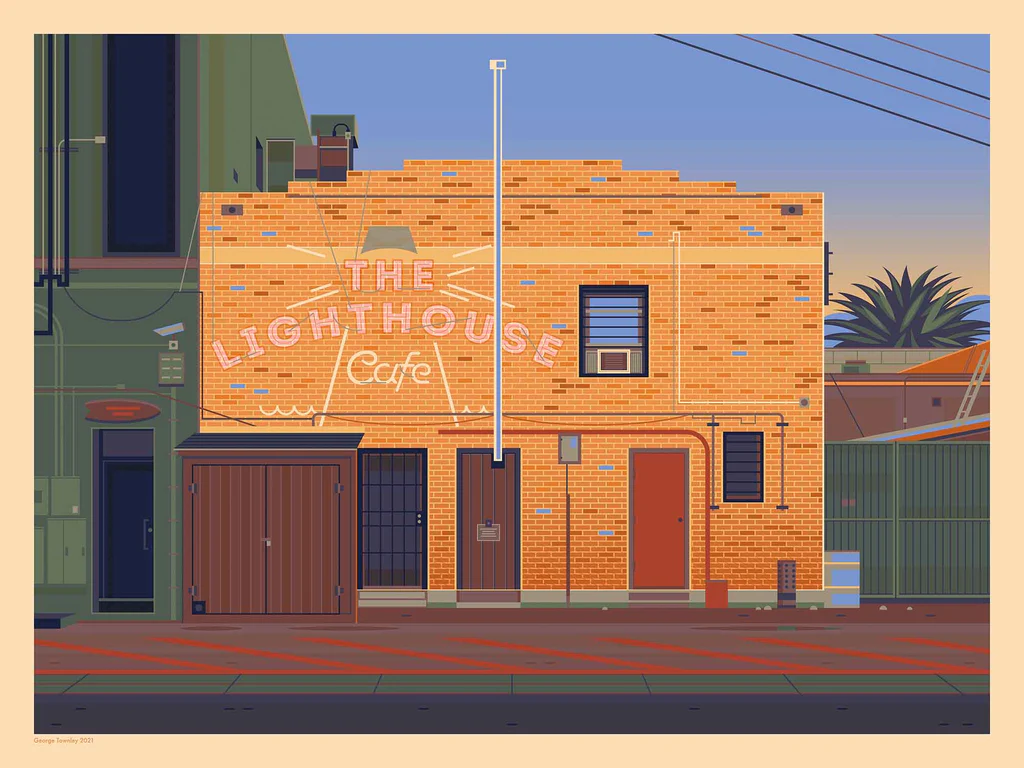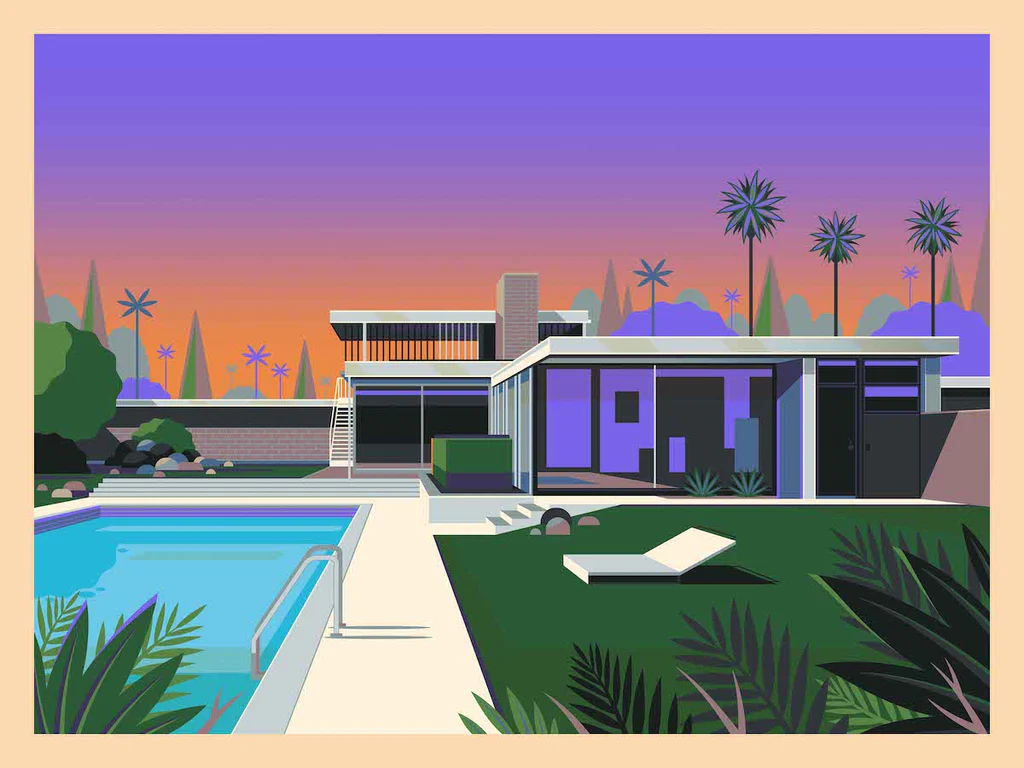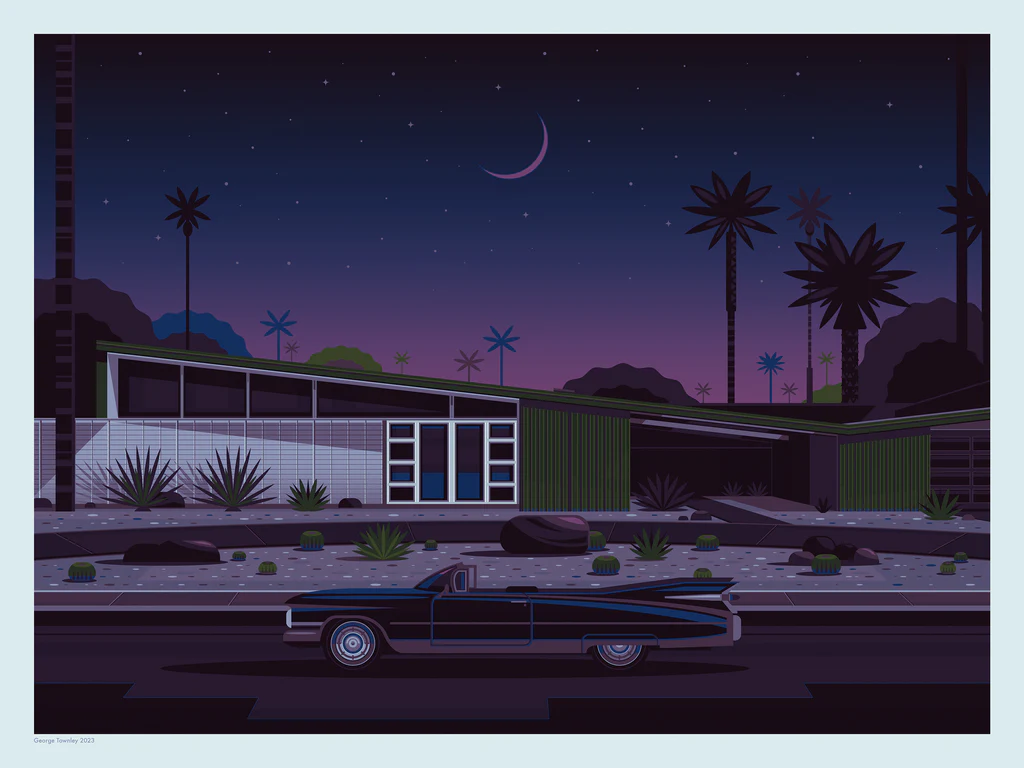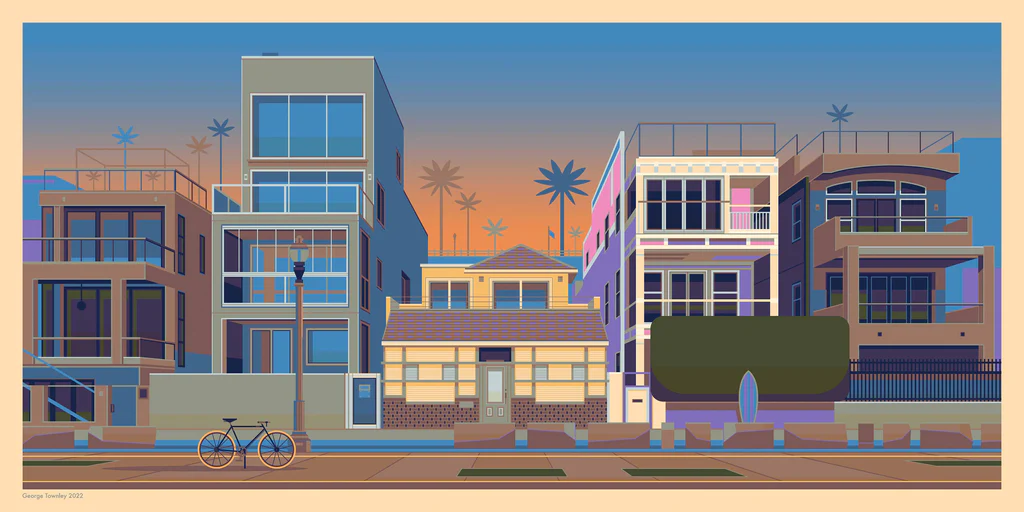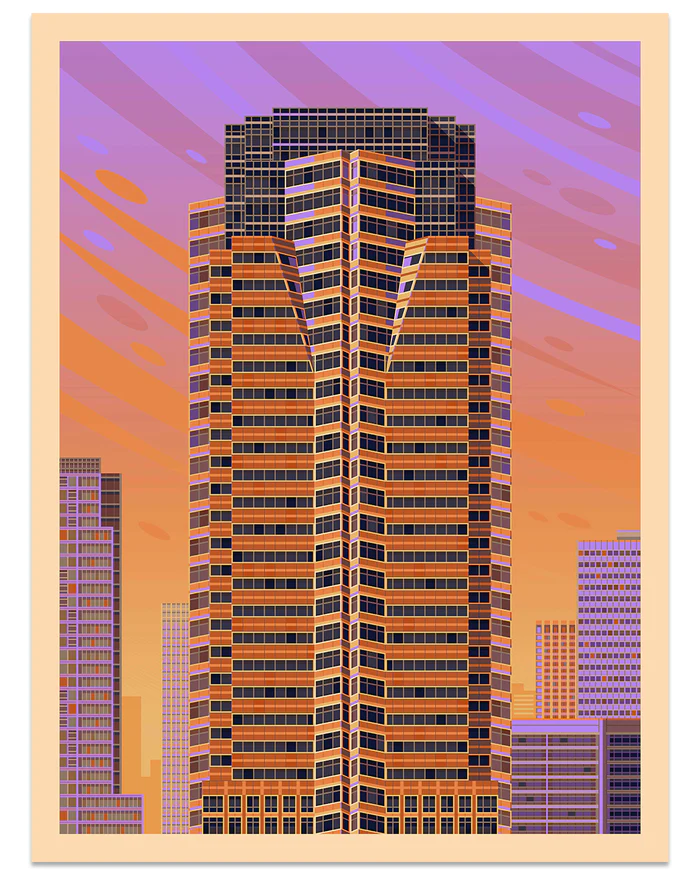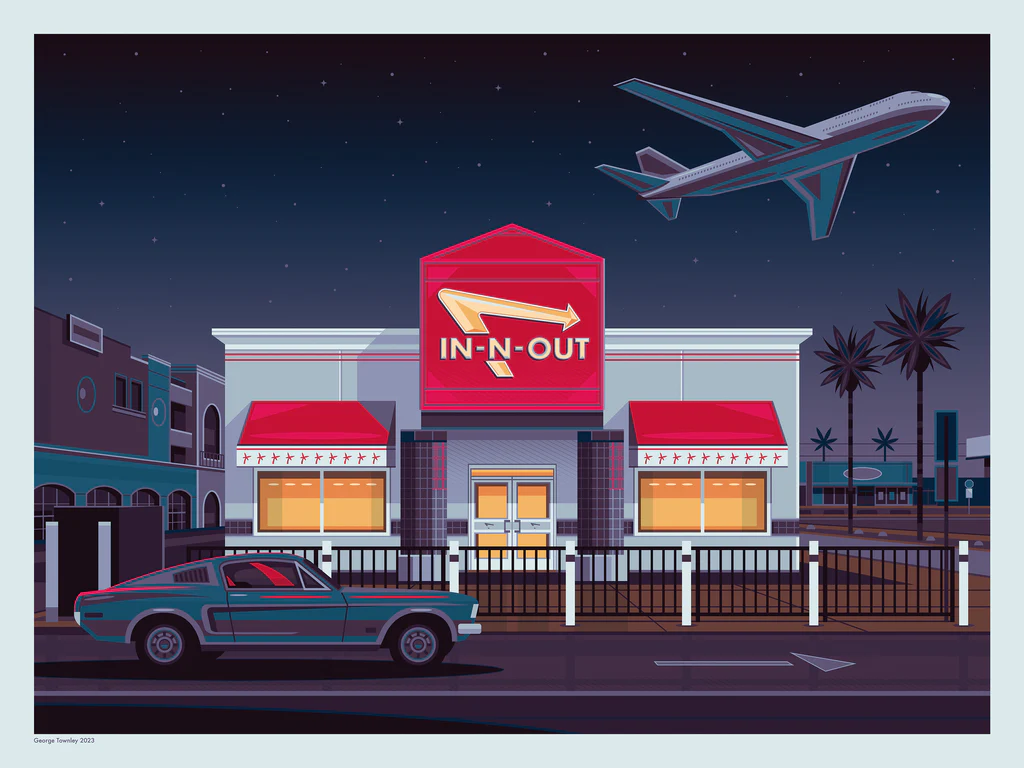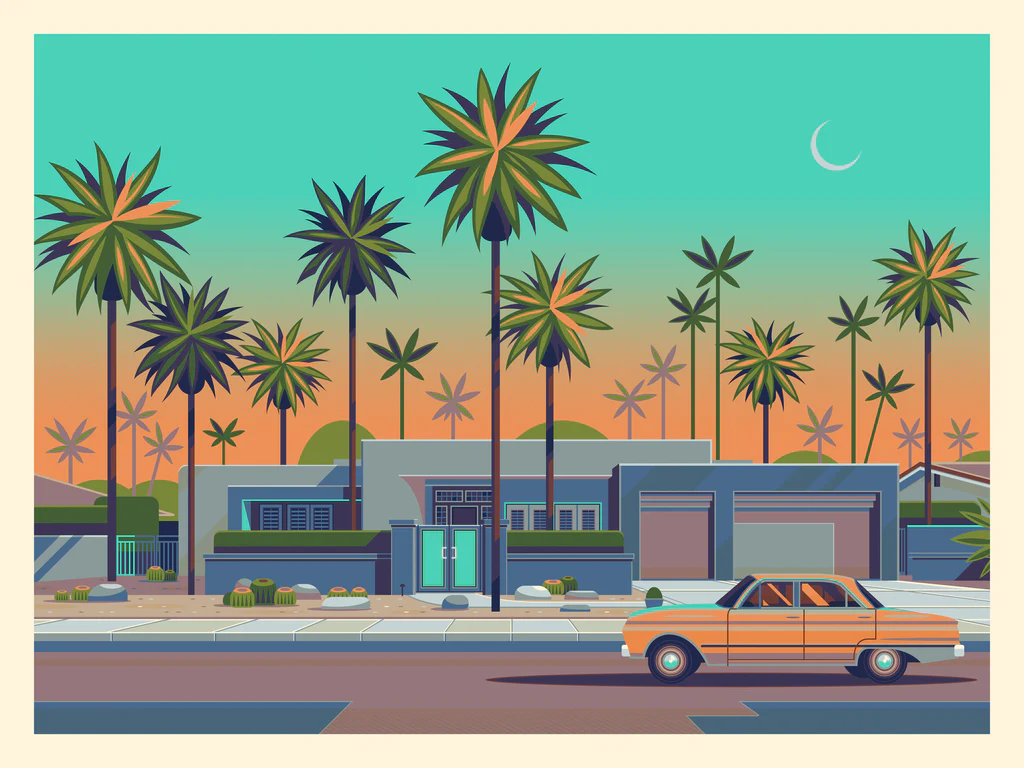On the occasion of the Salone del Mobile (16-21 April) and the release of a film on the famous painter Edward Hopper, Soggettiva Gallery dedicates an in-depth analysis of two symbolic places of American and world cinema, New York and Los Angeles. To do this, it borrow two disciplines other than the Seventh Art: art and architecture.
On the one hand, in fact, “Nighthawks” by Edward Hopper – “cinematic” painter par excellence (he influenced many directors including Alfred Hitchcock and David Lynch) to whom the documentary “Hopper. An American love story” is dedicated – is reinterpreted by the Texan illustrator Casey Callender, who inserts in the painting the most iconic protagonists of cinema: from Batman to The Big Lebowski, from Blade Runner to The Godfather, from Terminator to Matrix, Ghostbusters to Beetlejuice.
On the other hand, the architecture of Los Angeles represents an essential source of inspiration for the English artist George Townley, whose encounter with L.A. gave rise to a series of works that portray ordinary places – often made extraordinary by “cinematic” events, above all The Viper Room, linked to the tragic fate of River Phoenix – as well as sets of cult films – from Pearl Harbor to The Simpsons, from La La Land to Don’t Worry Darling and Karate Kid, from Barbie to The Dark Knight Rises.
DISPLAYING CINEMA IN NEW YORK
New York, in particular a classic American diner on Greenwich Avenue, inspires one of the most important paintings of the entire 20th century, Nighthawks by Edward Hopper: a work that transcends time and space by a painter who, with his works , has staged both the architecture and the landscapes, both real and of the soul, which distinguish the infinite nuances of a multifaceted country like the United States. The iconic image generated by Hopper is inspired by the Texan illustrator Casey Callender, who, by reinterpreting it, transforms it into a film set capable of welcoming the protagonists of the films that have marked our imagination, like the scene of a film lit by the best of photographers and furnished by the most meticulous of set designers.
The “main performers” of this scene are sitting at the counter like ordinary customers; if only from the shop window you can glimpse the terrifying extra-terrestrial creature of Alien (Ridley Scott) in the street, one of the bizarre beings that populate the Burtonian world of Beetlejuice, the iconic Batmobile parked behind Batman as well as the lethal airplanes flown by Tom Cruise in Top Gun. In some cases the place painted by Hopper is transported by Callender entirely into another dimension: be it the paranormal reality of the Ghostbusters – following the explosion of Stay Puft, with the ghostbusters covered in the soft marshmellow paste of which the gigantic ectoplasm is made – or the simulated one of the Matrix – with Neo and Morpheus immersed in a flow of alpha-numeric codes that make up what we believe to be the real world -, the result is always incredibly fascinating and a source of infinite interpretative ideas for fans of Edwardo Hooper’s paintings and above all of great cinema.
CALIFORNIA DREAMING
Taking a trip to the other coast of the United States, to Los Angeles, the encounter with cinema is simply inevitable, as this city is permeated with that filmic imagery that the Hollywood industry has been able to export all over the world. In this sense, the London artist George Townley developed a real obsession with the warm, soft light and saturated colors that make the Californian atmosphere unique.
The places that inspired Townley range from the El Rey Theater – historic cinema and art deco landmark built in 1936 where Bob Dylan, Billie Eilish, Kendrick Lamar and many others played, among others – to the Fox Plaza – made famous as Nakatomi Tower by Die Hard with Bruce Willis – from the Lighthouse Cafe – a real jazz cafe where the scene from La La Land in which Ryan Gosling meets John Legend was filmed – up to the Griffith Observatory – icon of Los Angeles and set of countless films including Youth burned, Yes Man and Terminator – and to the set that reproduces Barbie’s house, made 20% smaller than a traditional building to give it the aura of a real doll’s house.
Among the locations portrayed by Townely, Mulholland Drive could not be missing, known throughout the world thanks to the brilliant film of the same name by David Lynch: if in fact Townley inserts a clear reference to the director of Twin Peaks in a diner he reinterpreted, another reference This symbolic place is located in the Chemosphere, an unprecedented spaceship-shaped home designed by Californian architect John Lautner and located a few meters from Mulholland Drive.
ENNIS HOUSE AND OTHER ARCHITECTURAL MILESTONES
A focus is dedicated to the great architects who have left their mark on the Los Angeles skyline: from the spectacular Ennis House – for which the famous architect Frank Lloyd Wright was inspired by the buildings of the ancient Inca civilization – employed who set the futuristic city portrayed in Blade Runner, to the Kaufmann House designed by the Austrian designer Richard Neutra, whose geometric lines immersed in the lush nature of Palm Springs appear against the backdrop of the film Don’t Worry Darling.
ONCE UPON A TIME IN…HOLLYWOOD!
Finally, Townley’s works also refer to ordinary places: be it the Georgian Hotel, which over the years has hosted stars like Charlie Chaplin and Clark Gable, or the Californian fast food chain In n’ Out portrayed while a plane departed from LAX airport flies over it, or The Viper Room, a local that involuntary witnessed to a tragic event such as the premature death of the actor River Phoenix, the charm of Hollywood is always present, as if a city like Los Angeles, even in its less glamorous corners, was able to awaken in those who observe the desire to relive those stories that have become the very substance of the dreams that cinema inspires us wiht.
INFO
SOGGETTIVA GALLERY
Via Pasquale Sottocorno 5/A, 20122 Milano
3357722437 – 3458463222
Opening hours:
Tuesday to Friday 10 – 20.30
Saturday and Sunday 10-13.30 e 16-19.30
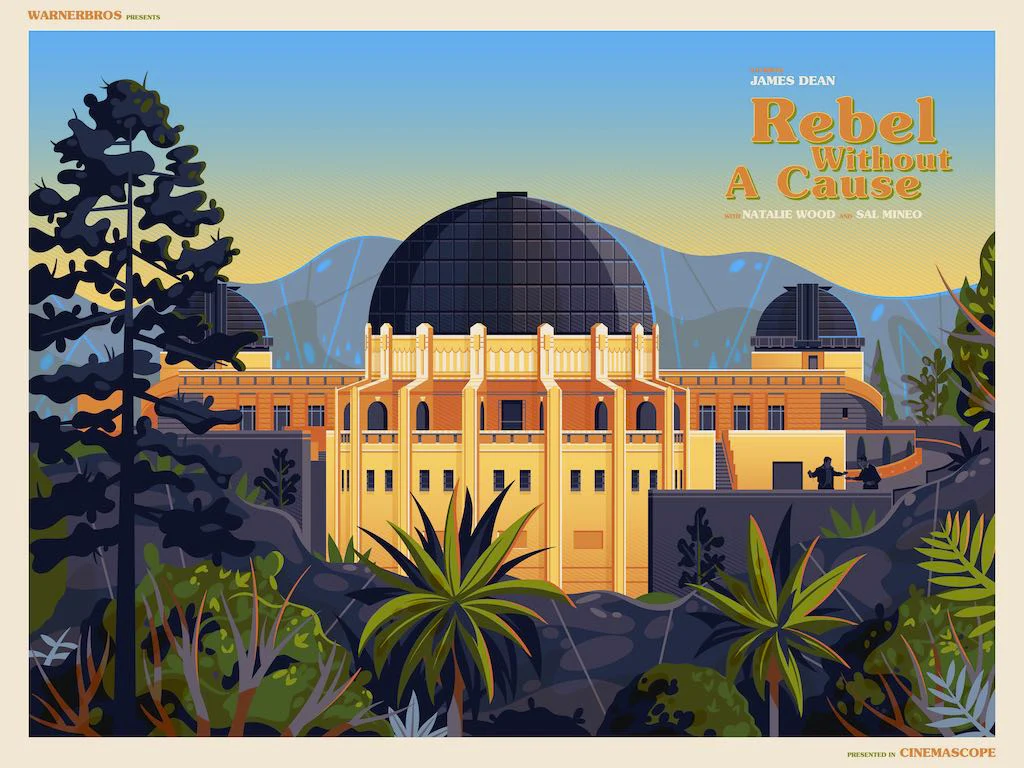


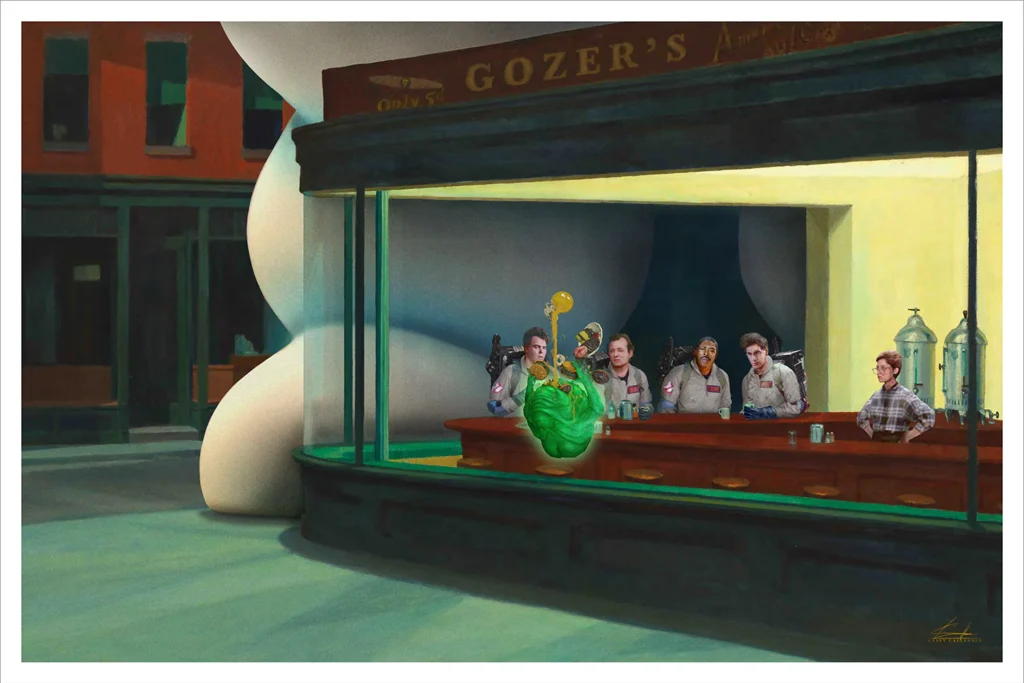
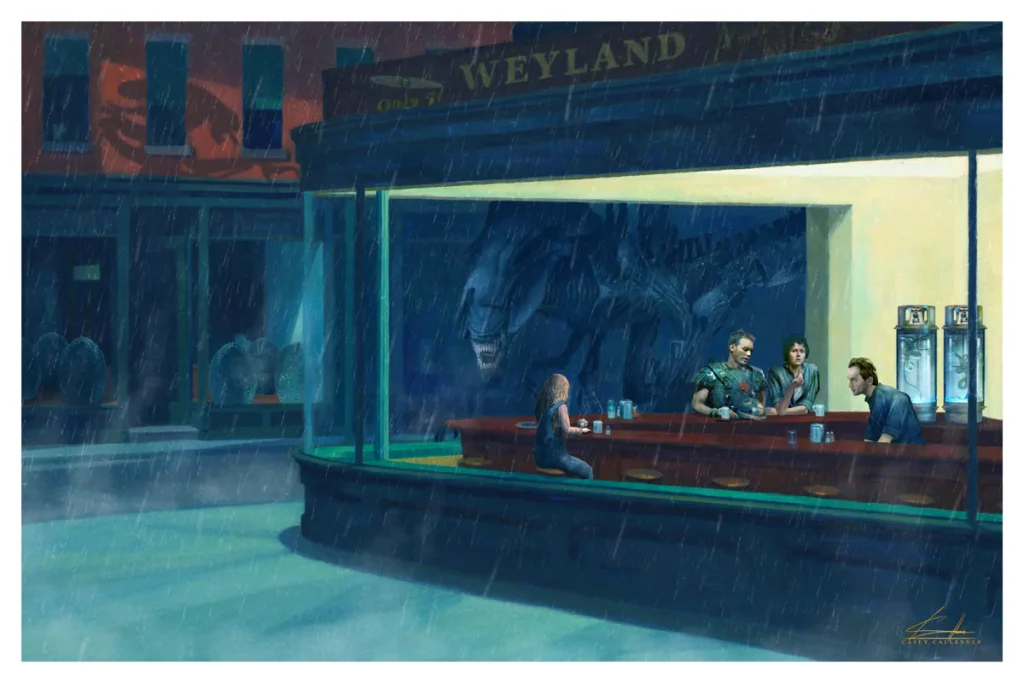
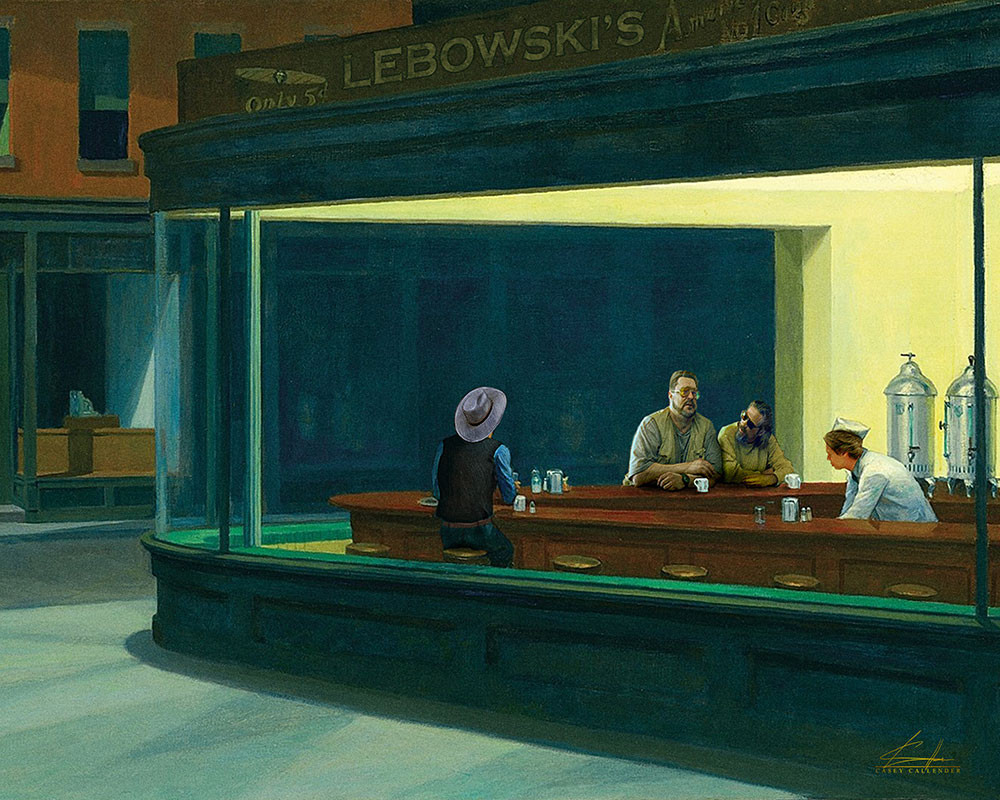

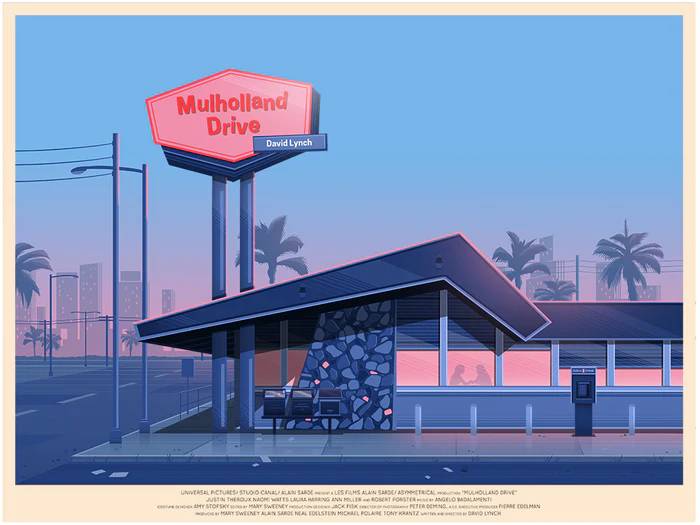
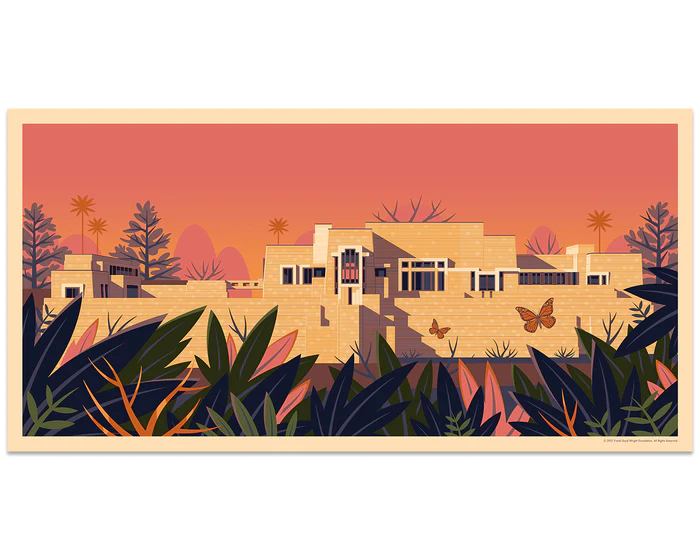
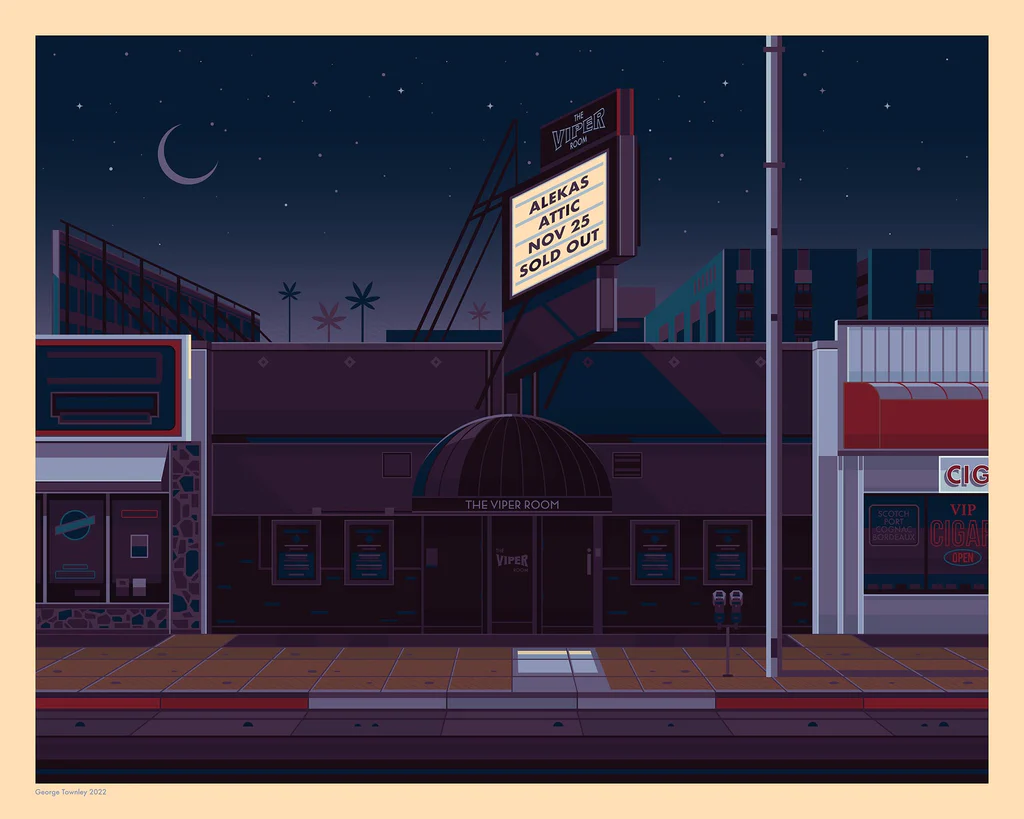
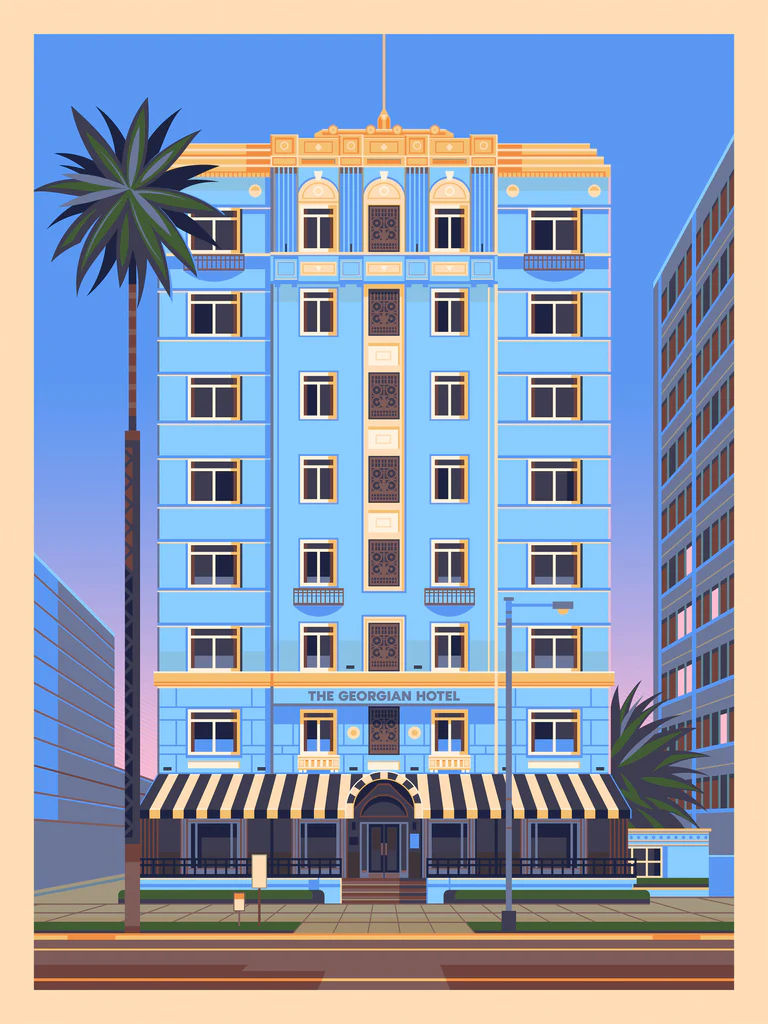
On the occasion of the Salone del Mobile (16-21 April) and the release of a film on the famous painter Edward Hopper, Soggettiva Gallery dedicates an in-depth analysis of two symbolic places of American and world cinema, New York and Los Angeles. To do this, it borrow two disciplines other than the Seventh Art: art and architecture.

On the one hand, in fact, “Nighthawks” by Edward Hopper – “cinematic” painter par excellence (he influenced many directors including Alfred Hitchcock and David Lynch) to whom the documentary “Hopper. An American love story” is dedicated – is reinterpreted by the Texan illustrator Casey Callender, who inserts in the painting the most iconic protagonists of cinema: from Batman to The Big Lebowski, from Blade Runner to The Godfather, from Terminator to Matrix, Ghostbusters to Beetlejuice.

On the other hand, the architecture of Los Angeles represents an essential source of inspiration for the English artist George Townley, whose encounter with L.A. gave rise to a series of works that portray ordinary places – often made extraordinary by “cinematic” events, above all The Viper Room, linked to the tragic fate of River Phoenix – as well as sets of cult films – from Pearl Harbor to The Simpsons, from La La Land to Don’t Worry Darling and Karate Kid, from Barbie to The Dark Knight Rises.

DISPLAYING CINEMA IN NEW YORK
New York, in particular a classic American diner on Greenwich Avenue, inspires one of the most important paintings of the entire 20th century, Nighthawks by Edward Hopper: a work that transcends time and space by a painter who, with his works , has staged both the architecture and the landscapes, both real and of the soul, which distinguish the infinite nuances of a multifaceted country like the United States.

The iconic image generated by Hopper is inspired by the Texan illustrator Casey Callender, who, by reinterpreting it, transforms it into a film set capable of welcoming the protagonists of the films that have marked our imagination, like the scene of a film lit by the best of photographers and furnished by the most meticulous of set designers.

The “main performers” of this scene are sitting at the counter like ordinary customers; if only from the shop window you can glimpse the terrifying extra-terrestrial creature of Alien (Ridley Scott) in the street, one of the bizarre beings that populate the Burtonian world of Beetlejuice, the iconic Batmobile parked behind Batman as well as the lethal airplanes flown by Tom Cruise in Top Gun. In some cases the place painted by Hopper is transported by Callender entirely into another dimension: be it the paranormal reality of the Ghostbusters or the simulated one of the Matrix, the result is always incredibly fascinating.

CALIFORNIA DREAMING
Taking a trip to the other coast of the United States, to Los Angeles, the encounter with cinema is simply inevitable, as this city is permeated with that filmic imagery that the Hollywood industry has been able to export all over the world. In this sense, the London artist George Townley developed a real obsession with the warm, soft light and saturated colors that make the Californian atmosphere unique.

The places that inspired Townley range from the El Rey Theater – historic cinema and art deco landmark built in 1936 where Bob Dylan, Billie Eilish, Kendrick Lamar and many others played, among others – to the Fox Plaza – made famous as Nakatomi Tower by Die Hard with Bruce Willis – from the Lighthouse Cafe – a real jazz cafe where the scene from La La Land in which Ryan Gosling meets John Legend was filmed – up to the Griffith Observatory – icon of Los Angeles and set of countless films including Youth burned, Yes Man and Terminator – and to the set that reproduces Barbie’s house, made 20% smaller than a traditional building to give it the aura of a real doll’s house.

Among the locations portrayed by Townely, Mulholland Drive could not be missing, known throughout the world thanks to the brilliant film by David Lynch: if in fact Townley inserts a clear reference to the director of Twin Peaks in a diner he reinterpreted, another reference This symbolic place is located in the Chemosphere, an unprecedented spaceship-shaped home designed by Californian architect John Lautner and located a few meters from Mulholland Drive.

ENNIS HOUSE AND OTHER ARCHITECTURAL MILESTONES
A focus is dedicated to the great architects who have left their mark on the Los Angeles skyline: from the spectacular Ennis House – for which the famous architect Frank Lloyd Wright was inspired by the buildings of the ancient Inca civilization – employed who set the futuristic city portrayed in Blade Runner, to the Kaufmann House designed by the Austrian designer Richard Neutra, whose geometric lines immersed in the lush nature of Palm Springs appear against the backdrop of the film Don’t Worry Darling.

ONCE UPON A TIME IN…HOLLYWOOD!
Finally, Townley’s works also refer to ordinary places: be it the Georgian Hotel, which over the years has hosted stars like Charlie Chaplin and Clark Gable, or the Californian fast food chain In n’ Out portrayed while a plane departed from LAX airport flies over it, or The Viper Room, a local that involuntary witnessed to a tragic event such as the premature death of the actor River Phoenix, the charm of Hollywood is always present, as if a city like Los Angeles, even in its less glamorous corners, was able to awaken in those who observe the desire to relive those stories that have become the very substance of the dreams that cinema inspires us wiht.
INFO
SOGGETTIVA GALLERY
Via Pasquale Sottocorno 5/A, 20122 Milano
3357722437 – 3458463222
Opening hours:
Tuesday to Friday 10 – 20.30
Saturday and Sunday 10-13.30 e 16-19.30


